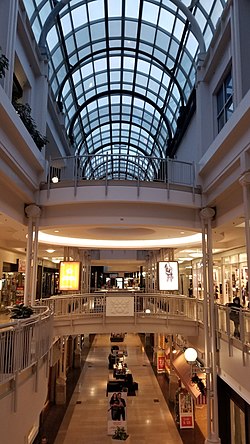 Interior of Circle Centre Mall in 2018 | |
 | |
| Location | Indianapolis, Indiana, United States |
|---|---|
| Coordinates | 39°45′59″N 86°9′34″W / 39.76639°N 86.15944°W |
| Address | 49 W. Maryland St. |
| Opening date | September 8, 1995 |
| Developer | Simon Property Group |
| Management | Hendricks Commercial Properties |
| Owner | Hendricks Commercial Properties |
| Architect | Ehrenkrantz & Eckstut Architects |
| No. of stores and services | 63 |
| No. of anchor tenants | 3 (2 open, 1 vacant) |
| Total retail floor area | 729,981 square feet (67,817.5 m2)[1] |
| No. of floors | 4 |
| Parking | Metered street parking, parking garages (2 underground, 1 aboveground) |
| Public transit access | |
| Website | www |
Circle Centre Mall is an indoor shopping mall located in Indianapolis, Indiana, United States. Circle Centre Mall was opened to the public on September 8, 1995, and incorporates existing downtown structures such as the former L. S. Ayres flagship store. The mall is anchored by Regal Cinemas and the offices for The Indianapolis Star. The space occupied by former anchor Carson Pirie Scott is vacant.
The mall consists of 99 stores on four levels with a gross leasable area of 729,981 square feet (67,817.5 m2). When first conceived in the 1980s, it was intended to contain the existing Ayres and William H. Block department stores along with one or two others new to the city. Before the mall could open, both the Ayres and Block stores had closed, leaving Nordstrom and Parisian (later converted to Carson's) as anchors.
The third level features a food court. The fourth level features entertainment venues (Tilt Studio and a nine-screen United Artists movie theater), but also now contains non-retail tenants.
The construction of the mall cost $307.5 million. Efforts were made in its design to incorporate historic elements, such as the retention of the facades of buildings that had previously existed on the site.
With the closure of Nordstrom in 2011 and that of Carson's on April 29, 2018,[2] the mall has no department stores. In response to the changing retail conditions, the mall has looked to non-traditional mall usages; in 2014, for example, The Indianapolis Star moved its offices into part of the space vacated by Nordstrom.
- ^ "Key Facts". Simon Property Group. Archived from the original on September 22, 2021.
- ^ Brinkers, Dave (April 28, 2018). "Lights out at Carson's downtown and across the country". WRTV-TV. Retrieved April 30, 2018.